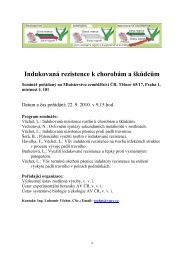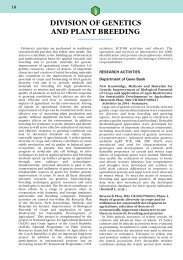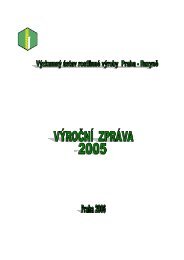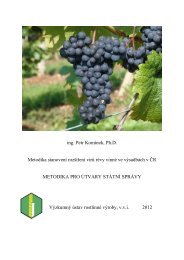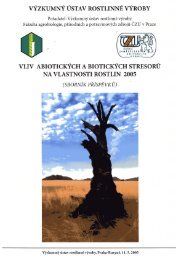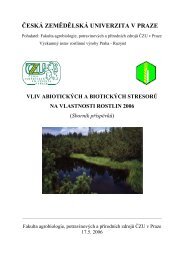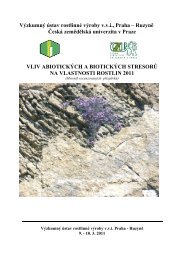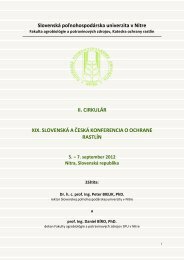00 ZLOM VURV 06 v roce 07
00 ZLOM VURV 06 v roce 07
00 ZLOM VURV 06 v roce 07
Create successful ePaper yourself
Turn your PDF publications into a flip-book with our unique Google optimized e-Paper software.
29<br />
cytological checks of the aneuploid constitution of<br />
monosomic materials, another glasshouse generation of<br />
self-pollination and molecular checks of chromosome<br />
substitutions using SSR markers of DNA were done.<br />
The presence of chromosome substitutions was<br />
confirmed in the substitution lines Mironovskaya 808<br />
(Bezostaya 1 5A), Bezostaya 1 (Mironovskaya 808 5A),<br />
Mironovskaya 808 (Bezostaya 1 5B) and Bezostaya 1<br />
(Mironovskaya 808 5B). These lines were used in the<br />
study of the relationship between vernalization<br />
response under the presence of recessive genes vrn-1<br />
and frost resistance. (Pánková K., Milec Z.)<br />
Phase 7: Study of wheat rust populations,<br />
powdery mildew and common bunt<br />
During the 2<strong>00</strong>6 vegetation period 72 isolates of leaf<br />
rust from 23 localities were obtained and tested on<br />
NILs with Lr genes (Lr1, Lr2a, Lr2b, Lr2c, Lr3, Lr9,<br />
Lr11, Lr15, Lr17, Lr19, Lr21, Lr24, Lr26, Lr28, Lr37).<br />
No virulence was found on NILs possessing Lr9 and<br />
Lr19 and Lr24.<br />
Gene for % virulent Gene for % virulent<br />
resistance isolates resistance isolates<br />
Lr 1 12 Lr 15 70<br />
Lr 2a 15 Lr 17 66<br />
Lr 2b 25 Lr 19 0<br />
Lr 2c 70 Lr 21 91<br />
Lr 3 94 Lr 23 86<br />
Lr 9 0 Lr 24 0<br />
Lr 10 95 Lr 26 72<br />
Lr 11 92 Lr 28 12<br />
In a field test with an inoculated spreader the resistance<br />
of newly registered cultivars and advanced lines to<br />
stem rust, yellow rust and leaf rust was tested.The results<br />
were compared with greenhouse tests. Main attention<br />
was paid to leaf rust. Most accessions possessing genes for<br />
specific leaf rust resistance were susceptible in field tests.<br />
The cultivar Batis was susceptible to all tested leaf rust<br />
isolates in the greenhouse but resistant in the field.<br />
In the field trials reactions of 30 cultivars and advanced<br />
lines of winter wheat, 12 cultivars of winter triticale<br />
and 3 cultivars of winter barley were tested for resistance<br />
to common bunt. Seed was inoculated with<br />
a mixture of Tilletia tritici and T. laevis. A low disease<br />
level was observed in 11 winter wheat cultivars and<br />
lines. No bunt occurred on cvs. Magnifik, Tommi,<br />
Trintella and line SW 51136. Average bunt incidence<br />
below 5% was determined in cvs. Globus, Mikon and<br />
Stava. In cultivars Bill, Lars and Tarso average bunt in<br />
cidence did not exceed 10%. Of the tested triticale cv.<br />
Ticimo had 0.4% bunted ears, cv. Triamant 2%, other<br />
10 triticale cultivars had no bunt infection. On winter<br />
barley after inoculation common bunt was not<br />
observed.<br />
In the field experiments the resistance of newly<br />
registered cultivars and advanced lines to powdery<br />
mildew was tested but the occurrence of powdery<br />
mildew was very low in consequence of high temperatures<br />
in that year (2<strong>00</strong>3, mainly in June). During the<br />
vegetation period 20 isolates of powdery mildew were<br />
obtained and tested on differential varieties with different<br />
Pm genes (Pm1; Pm2; Pm3a; Pm3b; Pm3c; Pm4a;<br />
Pm4b; Pm5; Pm6; Pm8; Pm17; Pm2, 6; Pm2, 4b, 8;<br />
Pm3d; Pm7; Pm1, 2, 9).Tests of the resistance of wheat<br />
cultivars to Septoria tritici blotch on leaf segments were<br />
started. Resistance of the tested cultivars fluctuated<br />
with used isolates of the pathogen.The effectiveness of<br />
inductors of systemic acquired resistance to powdery<br />
mildew in wheat was examined. All used inductors<br />
except salicylic acid induced resistance to powdery<br />
mildew. (Hanzalová A., Barto‰ P., Dumalasová V.,<br />
Vûchet L.)<br />
Utilization of innovated methods and specific<br />
breeding materials to increase the effectiveness<br />
of production of new winter rapeseed cultivars<br />
(Project MZe âR 1G46<strong>06</strong>1)<br />
About 1 6<strong>00</strong> new doubled haploid (DH) regenerants<br />
from F1 initial materials for the breeding of line and<br />
hybrid cultivars were developed. Advanced DH lines<br />
were evaluated in location trials and they yielded 90.46<br />
–1<strong>00</strong>.09% in comparison with standard cultivars.<br />
Eleven reliable restorers of fertility (Rf) for CMS<br />
Ogu-INRA with improved <strong>00</strong> quality were selected.<br />
The method of DNA markers for fatty acid assessment<br />
showed a high correlation coefficient for linolic acid<br />
with the standard method of gas chromatography.<br />
DNA analysis of self-incompatible (SI) plants based on<br />
PCR RFLP was found to be reliable for the detection<br />
of SI genotypes. Three F1 hybrids of CMS Shaan 2A<br />
lines with cv. Californium were obtained by means of<br />
honeybees as pollinators in isolation cages.<br />
Calibration equations for a laboratory instrument<br />
Foss-NIRSystem 65<strong>00</strong> were developed for the assessment<br />
of oleic, linolic and linolenic acid content.<br />
Molecular SCAR marker for the detection of fertility<br />
restorers (Rf) for Ogu-INRA has been successfully<br />
verified.<br />
Based on field and laboratory testing several sets of<br />
breeding materials with different susceptibility to<br />
important pathogens were created and included in field<br />
trials.Ten advanced DH lines were included in location<br />
performance trials. (Kuãera V., Vyvadilová M.,<br />
Klíma M.)<br />
Utilization of a protoplast fusion technique<br />
in the breeding of important cultivated crops<br />
of the genera Brassica, Cucumis and Solanum<br />
(MZe âR QF4108)<br />
Haploid (H) and doubled haploid (DH) regenerants<br />
derived from 3 cultivars of B. juncea (Domo, Opaleska,<br />
RLM 619) and B. carinata genotype BC11 are cultured<br />
in vitro as a source of protoplasts. Interspecific chemical<br />
fusions were carried out between DH B. carinata x DH<br />
OP-1 B. napus and H B. carinata x H B. juncea cv.<br />
Domo. Division of protoplasts and shoot regeneration<br />
were achieved in all fusion combinations. Regenerants<br />
from fusions between mesophyll protoplasts of DH B.<br />
carinata and hypocotyl protoplasts of DH OP-1 B. napus<br />
are prepared for laboratory and greenhouse evaluation.<br />
Whole plants were also developed after the protoplast




